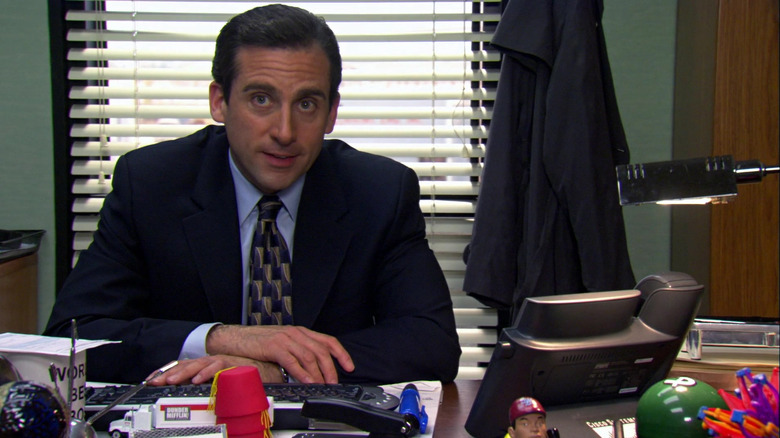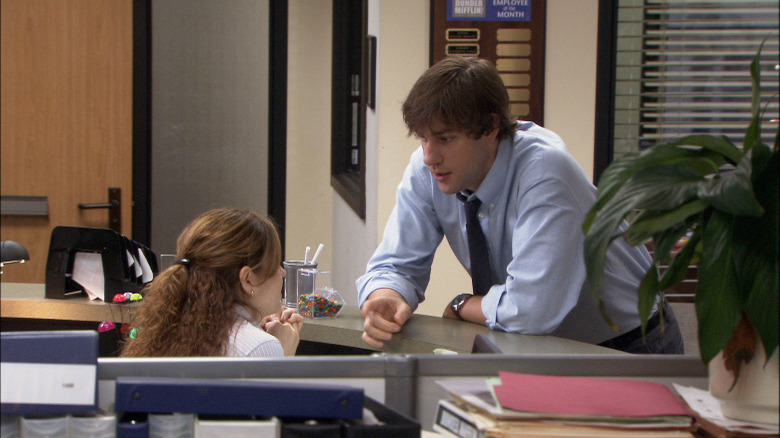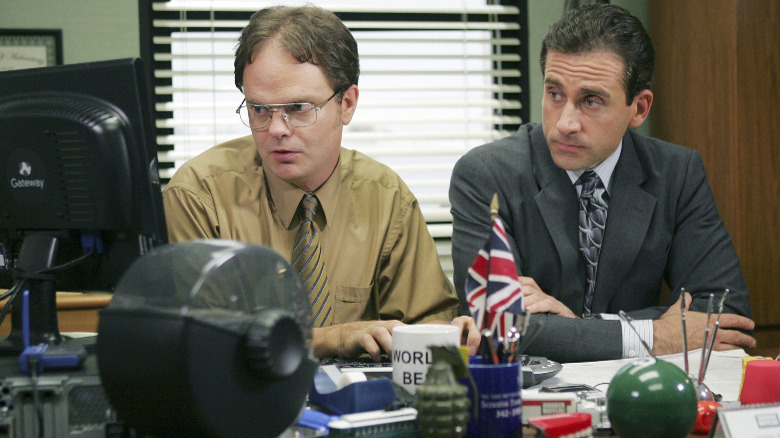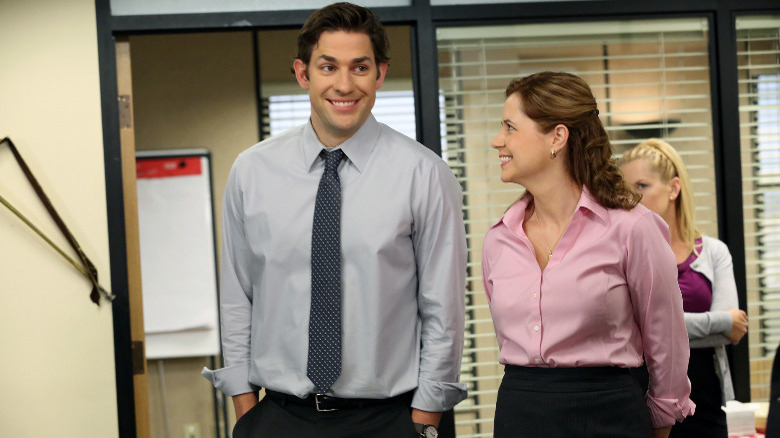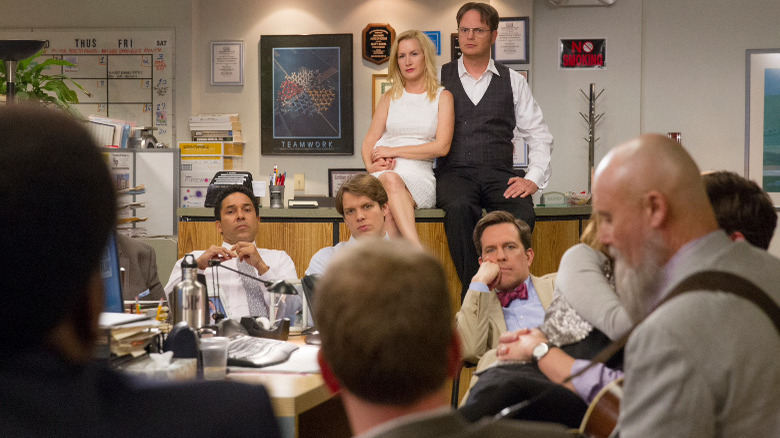How The Office Creator And Directors Made The Documentary Style Feel So Natural
The U.S. version of "The Office" came along at a key point in the history of reality TV. At the end of the 20th century, the format had only recently been the target of ridicule and satire in the movies like "The Truman Show" and "EDtv." However, by the time "The Office" premiered in 2005, reality series like "Big Brother" and "Survivor" had come to dominate the airwaves. So rather than trying to fight the tide, "The Office" creator Greg Daniels embraced it, even going so far as to seek out a director of photography with personal experience in this newfangled form of entertainment.
Like the original British sitcom created by Ricky Gervais and Stephen Merchant, the U.S. version of "The Office" is a mockumentary series about the daily lives of the employees at a fictional paper company in Scranton Pennsylvania called Dunder Mifflin. Mockumentary TV was, of course, nothing new in 2005. Gervais and Merchant had used the same approach for their iteration of the show, as had comedy sketch series like "Monty Python's Flying Circus" back in the late 1960s. Still, as more and more viewers became familiar with the aesthetics of actual documentaries thanks to the boom in reality TV, Daniels knew he needed to step up his game.
In Andy Greene's book "The Office: The Untold Story of the Greatest Sitcom of the 2000s," Daniels explains that he wanted to build on the work done by cinematographer Peter Smokier ("This Is Spinal Tap") in the pilot for "The Office" at NBC:
"I wanted to find someone to DP from reality television, and [executive producer] Ben Silverman had worked with this brilliant guy, Randall Einhorn, who was a camera operator on 'Survivor.'"
'The show is a tofu hot dog'
"The Office" director and cinematographer Randall Einhorn came from "an outdoor adventure background," having gotten his start filming his rafting trips as a white-water kayaker. This led him to a gig shooting "Eco-Challenge," the adventure racing series created by "Survivor" executive producer Mark Burnett in 1995. Einhorn would later be hired to work on the first season of "Survivor," along with what Einhorn not-so-lovingly described as "some horrendous piece-of-s*** reality TV" and "extreme sports stuff" featuring the famed snowboarders Shaun White and Jeremy Jones:
"Ben [Silverman, then co-chairman of NBC Entertainment and Universal Media Studios] was in the tent one night watching me filming these guys and he's like, 'That's the guy we've gotta hire.' He totally sold me to Greg [Daniels] and said, 'This is the guy we need to hire to DP this series.'"
Unlike some of the, ahem, less ambitious reality TV series Einhorn has been involved with, he quickly recognized "The Office" had some real substance to it. As he told Daniels during their first meeting, "The show is a tofu hot dog. It's good food disguised as junk food."
Realizing the pair were on the same page, Daniels more or less hired him on the spot. Einhorn would go on to bring in two more camera operators ("Survivor" alum Matt Sohn and Sarah Levy) with a documentary and reality TV background, and together the three served as the cinematographers on the first season of "The Office." But rather than vying to adapt their methods to the medium of scripted TV, Sohn said their goal was to "give this sitcom a documentary feel."
Going from the wide to the tightest shot
One of the ways Randall Einhorn and his team went about making "The Office" really feel like a documentary was to shoot it with a "single-camera" setup like the one they used on reality TV series (although, in truth, they actually had two cameras in play). That meant strapping the cameras to the camera operators' shoulders and having them move around the actors, much like they had with the contestants on "Survivor." The important thing was to make the camera-work feel spontaneous, as though the cinematographers didn't know what was going to happen next.
Here's how Matt Sohn breaks down the traditional approach to filming sitcoms in Andy Greene's book:
"On most any kind of scripted show, the camera operator is using a dolly and he has what is known as a 'cowboy shot,' which is a shot that goes from just above the knees to the top of the head. That operator is going to get a beautiful shot and hold it steady. He also might have a tight shot that is just of the chest and head and it's going to be a beautiful shot too."
With "The Office," on the other hand, Sohn and the others would typically shift from a wide-angle shot to "our tightest shot in a matter of seconds just to find those reactions and to keep it moving," just as they would when shooting a reality TV series. This technique would prove to be particularly effective at creating the illusion whatever's happening on the show wasn't planned ahead of time, so much so that even non-mockumentary series have used this trick in the years since then to create a richer sense of realism, like "Succession."
The camera operators are characters
As filming went along, the cinematographers on "The Office" learned to break up the set into different areas for each of them to cover. "The way that Matt [Sohn] and I shot that show is we just observed it. We just reacted," said Randall Einhorn, adding they would go out of their way to avoid premeditating how they would shoot any given scene.
Paul Feig, who directed 15 episodes of "The Office," comments on this in Andy Greene's book, noting that Greg Daniels "didn't want anybody to be aware of the camera, He'd rather the cameraman not see any rehearsal and just do it." In time, Daniels came to recognize the importance of treating the camera operators as characters, as if they were the actual crew members making the documentary within the show:
"[The camera operator] became a character in the show because Randall had a lot of judgment and leeway about where he was looking. And often that adds a tremendous amount of comedy, choosing to look over here to see what this person thinks and [going] back and forth. He was definitely a hidden character in the show."
This also made it okay for the camera to be looking at the "wrong" character in certain scenes. Ken Kwapis, who directed 13 episodes of "The Office" (including the series finale), also noted as much, pointing out how the camera would often focus on one character only for another to start talking and finish before it could pan over to them:
"We'd pan occasionally to find nothing but dead air. At the beginning at least, there were times when we tried to not be in the right place at the right time, to create the illusion that we were catching this by accident."
Dirty shots
Adding to the naturalistic vibe on "The Office" were what Matt Sohn referred to as "dirty" shots where someone or something would be blocking the frame. These were all the easier for the show's cinematographers to create thanks to the show's setting. Said Sohn:
"[The] great thing is we not only had those blinds, but we also had the partitions between the desks or just a bookshelf or something. And what's interesting is that with other shows, you might move stuff in front of the camera to find those dirty shots, but we never did. We would make it feel truly authentic, and we would really be where we would have to be jammed on the floor into a corner behind a bush. We had some potted plants that we would get kind of behind and crouch to make it feel even more spy than usual."
Virtually all of these tricks are still used by mockumentary series to this day, many of which put their own playful spin on them — like the way "What We Do in the Shadows" will have the documentary crew within the show being threatened by the very supernatural creatures they're filming, for instance. That alone is testament to just how successful "The Office" truly was at emulating the style of actual reality TV series at a time when faking authenticity was suddenly harder than ever to pull off.
